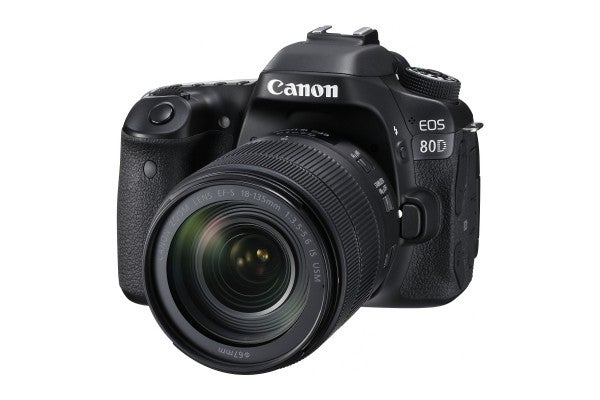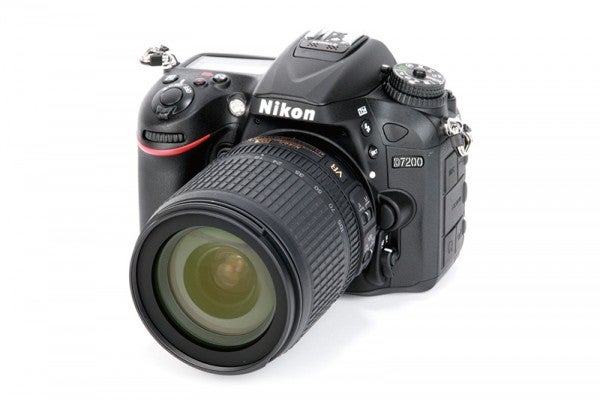Find the right camera for your budget in our round up of the best cameras under £1000.
In this article, we’re taking a look at six of the best cameras which you can buy which will give you change from a cool £1000. Some of them come with lenses, others don’t.
We have guidance for a range of budgets, so if you’ve got a bit less cash to spend, have a look at our Best Cameras for under £800 article.
For advice on choosing the best type of camera for your needs, see our choosing a camera type article.
Canon EOS 80D (body only)

Price: £999
Sensor: 24.2MP APS-C CMOS
ISO: 100-16,000 (extendable to ISO 25,600)
Drive mode: 7fps
AF: 45-point cross type
Display: Touch-screen vari-angle 3.0-inch 3:2 Clear View II TFT, approx 1040k-dots
Sitting proudly at the top of Canon’s APS-C range of EOS DSLR cameras, the 80D is an ideal camera for a wide-range of different photographers and styles of photography. It is designed to be a fantastic all-rounder and can produce excellent results in all different kinds of conditions. It has a high resolution sensor which benefits from Dual Pixel CMOS AF technology which boosts performance when using Live View or shooting video. All 45 of the AF points on the sensor are the more sensitive cross-type, with 27 f/8 compatible – that’s great news for wildlife photographers who like to shoot with converters. Other useful features include a touch-sensitive screen, a 7fps burst shooting speed and Wi-Fi and NFC connectivity built in.
See best deals for the Canon EOS 80D
Sony a6300 (body only)

Price: £974
Sensor: 24.2MP APS-C CMOS
ISO: 100 – 51,200
Drive mode: 11fps
AF: 425 phase-detection points
Display: 921k-dot, tiltable 3-inch 3:2 screen
Sony’s latest APS-C sensor compact system camera has been gaining a lot of positive press for its range of high-end and well-performing specifications. The A6000 has been an extremely well selling camera for Sony, so its successor needs to be up to scratch. It has a 24.2 million pixel CMOS sensor, which has copper rather than aluminium wiring. Without getting too far into the physics of it, this basically means that data readout is much faster. The photodiodes on the sensor have also been made larger to allow more light to be captured, which when combined with the BIONZ X processor should mean fantastic low light performance. The 425 phase detection AF points cover virtually the whole scene, with incredibly quick speeds promised. A new AF tracking mode has also been developed for the camera, which makes it great for shooting moving subjects, too. In short, this is one of the best compact system cameras currently on the market and perhaps marks the first time where the line between DSLRs and CSCs is starting to become thinner and thinner.
See best deals for the Sony a6300
Nikon D7200 (with 18-105mm VR lens)

Price: £839
Sensor: 24.2MP APS-C CMOS
ISO: 100 – 25,600 (102,600 expandable)
Drive mode: 6fps
AF: 51-points
Display: 3.2-inch 1.23 million-dot 3-inch TFT LCD
Like Canon’s 80D, the Nikon D7200 is designed to be an all-rounder which can cope with a range of different shooting conditions. It’s not quite at the top of the APS-C pile, as the newer D500 has now been announced, but it is aimed more squarely at hobbyist enthusiasts. It features a 24.2 million pixel sensor, which as it’s APS-C sized has proven popular with wildlife and sports photographers due to the crop factor giving your telephoto lenses a little extra reach. The 6fps drive mode should also be appealing for those kinds of photographers, too. It’s got a robust build, and is weather sealed for increased durability.
See best deals for the Nikon D7200
Olympus PEN-F (body only)

Olympus’s retro-styled Pen-F is its first Micro Four Thirds model with a 20MP sensor
Price: £999
Sensor: 20MP Four Thirds CMOS
ISO: 80-25600 (extended)
Drive mode: 10/20fps
AF: 81-point contrast detect AF
Display: 1.04 million dot 3-inch fully articulated screen
Keen to continually build on the company’s heritage, the PEN F has all the retro charm we’ve come to expect from Olympus. Its the first in the series of digital PEN cameras to include an electronic viewfinder, which blurs the line a little between the PEN and the OM-D series. It’s also the first Olympus Micro Four Thirds model to use a 20-million-pixel sensor. It can shoot at a fantastic 10fps, or 20fps if you’re happy to use the electronic shutter. Although the camera is arguably a stylish proposition, it doesn’t do away with too much substance to provide that and makes for a great all-round camera for many different users. You might also want to think about the Olympus OM-D E-M5 Mark II if you’re happy to pay a bit less for something which isn’t quite so pretty.
See best deals for the Olympus PEN-F
Panasonic GH4R (body only)

Price: £999
Sensor: 16.05 Live MOS Four Thirds sensor
ISO: 200 – 25,600
Drive mode: 12fps
AF: 49 contrast-detect AF points
Display: 3-inch, 1,036,000-dot TFT LCD
The GH4R is a slightly tweaked version of the original GH4, with some extra functionality specifically designed to appeal to videographers. Panasonic says that the GH4R is outselling the original camera now, but you can still pick up the original for a slightly cheaper price if you don’t do much video recording. Either way you have a 16 million-pixel sensor, in a body which is very DSLR-like and is weather-sealed to give it rugged credentials. There’s lots of room for customising the GH4’s controls, and it suits both stills photographers and videographers pretty much equally, with the latter especially well catered for by 4K video recording.
See best deals for the Panasonic GH4
Fuji X-T1 (body only)

Price: £805
Sensor: 16.3MP APS-C sized X-Trans CMOS
ISO: 200-6400 (extended to 100 – 51200)
Drive mode: 8fps
AF: 77-point hybrid AF system
Display: 3-inch, 1.04-million-dot LCD
Oozing retro charm, the X-T1 features a very highly regarded X Trans CMOS sensor which has been proven to resolve more detail than some full-frame sensors. It has an ultra-fast hybrid AF system which switches between phase detection and contract detection depending on the subject, with speeds as fast as 0.08 seconds quoted. There’s a large electronic viewfinder, with a tilting LCD screen that combine to make an excellent shooting experience. Wi-Fi is included for wireless image transfer and remote shooting, while there’s also full HD video recording.





